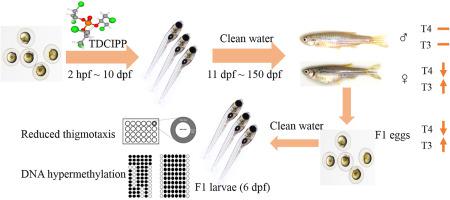Environmental Pollution ( IF 7.6 ) Pub Date : 2021-05-28 , DOI: 10.1016/j.envpol.2021.117471 Ruiwen Li 1 , Lihua Yang 2 , Jian Han 2 , Yu Zou 3 , Yingcai Wang 4 , Chenglian Feng 5 , Bingsheng Zhou 2

|
Tris (1,3-dichloro-2-propyl) phosphate (TDCIPP), an alternative to brominated flame retardants, might pose an exposure risk to humans and wild animals during fetal development. Our recent study suggested that short-term TDCIPP exposure during early development caused sex-dependent behavioral alteration in adults. In the present study, multigenerational neurodevelopmental toxicity upon early-life exposure of parental zebrafish was evaluated, and the possible underlying mechanisms were further explored. Specifically, after embryonic exposure (0–10 days post-fertilization, dpf) to TDCIPP (0, 0.01, 0.10, and 1.00 μM), zebrafish larvae were cultured in clean water until the sexually matured to produce progeny (F1). The results confirmed neurodevelopmental toxicity in F1 larvae characterized by changes of developmental endpoints, reduced thigmotaxis, as well as altered transcription of genes including myelin basic protein a (mbpa), growth associated protein (gap43) and synapsin IIa (syn2a). Sex-specific changes in thyroid hormones (THs) indicated the relationship of abnormal THs levels with previously reported neurotoxicity in adult females after early-life exposure to TDCIPP. Similar changing profiles of TH levels (increased T3 and decreased T4) in adult females and F1 eggs, but not in F1 larvae, suggested that the TH disruptions were primarily inherited from the maternal fish. Further results demonstrated hypermethylation of global DNA and key genes related to TH transport including transthyretin (ttr) and solute carrier family 16 member 2 (slc16a2), which might affect the transport of THs to target tissues, thus at least partially contributing to the neurodevelopmental toxicity in F1 larvae. Overall, our results confirmed that early-life TDCIPP exposure of parental fish could affect the early neurodevelopment of F1 offspring. The underlying mechanism could involve altered TH levels inherited from maternal zebrafish and epigenetic modifications in F1 larvae.
中文翻译:

生命早期暴露于三(1,3-二氯-2-丙基)磷酸盐通过改变母体甲状腺激素转移和表观遗传修饰导致斑马鱼的多代神经发育毒性
三(1,3-二氯-2-丙基)磷酸酯 (TDCIPP) 是溴化阻燃剂的替代品,在胎儿发育期间可能会对人类和野生动物造成暴露风险。我们最近的研究表明,早期发育过程中的短期 TDCIPP 暴露会导致成人的性别依赖性行为改变。在本研究中,评估了亲本斑马鱼早期暴露对多代神经发育的毒性,并进一步探讨了可能的潜在机制。具体而言,在胚胎暴露于 TDCIPP(0、0.01、0.10 和 1.00 μM)后(受精后 0-10 天,dpf),斑马鱼幼虫在干净的水中培养,直到性成熟产生后代(F1)。结果证实了 F1 幼虫的神经发育毒性,其特征是发育终点的变化、趋向性降低、mbpa )、生长相关蛋白 ( gap43 ) 和突触素 IIa ( syn2a )。甲状腺激素 (THs) 的性别特异性变化表明,异常 THs 水平与先前报道的成年女性在生命早期暴露于 TDCIPP 后的神经毒性之间存在关系。成年雌性和 F1 卵中 TH 水平的类似变化(增加 T3 和降低 T4),但在 F1 幼虫中没有,这表明 TH 中断主要是从母鱼遗传的。进一步的结果表明,全球 DNA 和与 TH 转运相关的关键基因包括转甲状腺素蛋白 ( ttr ) 和溶质载体家族 16 成员 2 ( slc16a2 ) 的超甲基化),这可能会影响 THs 向靶组织的转运,因此至少部分地导致了 F1 幼虫的神经发育毒性。总体而言,我们的结果证实,亲代鱼的早期 TDCIPP 暴露可能会影响 F1 后代的早期神经发育。潜在的机制可能涉及从母斑马鱼遗传的 TH 水平的改变和 F1 幼虫的表观遗传修饰。











































 京公网安备 11010802027423号
京公网安备 11010802027423号